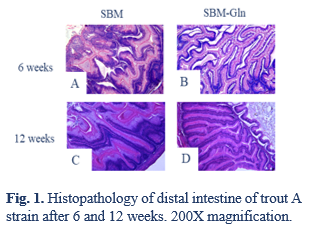MONITORING THE DEVELOPMENT AND MITIGATION OF SOYBEAN MEAL INDUCED ENTERITIS (SBMIE) IN TWO DIFFERENT STRAINS OF RAINBOW TROUT Oncorhynchus mykiss OVER A 30 -WEEK LONG TERM FEEDING TRIAL
Plant protein sources have been largely studied for their potential in replacing fish meal (FM) as the main source of protein in aquafeeds. Specifically, soybean meal (SBM) has been widely used at high inclusion levels to improve sustainability and affordability of fish feeds. However, carnivorous species like rainbow trout (Oncorhynchus mykiss) are susceptible to feeds formulated with high inclusions of SBM, exhibiting reduced growth rates and distal intestinal inflammation or enteritis. Mitigation of SBM-induced enteritis (SBMIE) may be done by dietary supplementation of L-glutamine (Gln) because it regulates the development and function of the intestinal tract in fis h.
The goal of this study was to evaluate the potential mechanisms by which Gln might exert a protective effect on reducing inflammation and restore barrier function in two different commercial strains (A and B) of rainbow trout over a long-term experimental period. A total of 2,250 fish (strain A= 1125 and strain B = 1125), initially weighing ~ 25.0 ± 1.0 g, were randomly distributed into 18 350-L tanks (125 fish/tank). Three experimental diets (isonitrogenous: 40% crude protein and isolipidic: 20% lipid) included a FM diet (control), a SBM diet (30% inclusion level) and a SBM-Gln diet ( 1.5% L-Alanyl-Gln) were fed to both strains at apparent satiation for 30 weeks . During the trial fish were sampled five times at 6, 12, 18, 24 and 30 weeks.
Growth performance in terms of weight gain only showed differences for strain A at 18 weeks , being significantly higher in fis h fed the SBM diet. ( p < 0.05). Histology analyses of distal intestine showed significant differences (p < 0.05) in terms of villi length and width at all dietary treatments, and inflammation was reduced in the SBM-Gln group in both strains (Fig. 1). Samples were collected from the distal intestine for gene expression analyses of the inflammatory markers: TNF-α, NF-κB, IL-8, IL-10; barrier function markers: MLCK, ZO-1, occludin ; as well as brush border transporters: FABP2, and SLC1A5. Distal intestine samples were also collected to evaluate glutathione peroxidase enzymatic activity and glutamate quantification.
Overall, the data show a positive effect of Gln in SBMIE histology after 12 weeks of dietary exposure in both strains . Enzyme activity and gene expression analyses in the distal intestine will help elucidate the molecular mechanism underlying Gln driven SBMIE mitigation.
